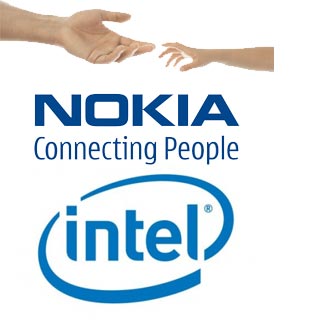 Intel Corporation and Nokia lately publicized their enduring relationship which aims at developing a new category of Intel based mobile computing device and chipset designs. It would integrate the performance of powerful computers, concurrently offering high-bandwidth mobile broadband communications and the omnipresent Internet connectivity.
Intel Corporation and Nokia lately publicized their enduring relationship which aims at developing a new category of Intel based mobile computing device and chipset designs. It would integrate the performance of powerful computers, concurrently offering high-bandwidth mobile broadband communications and the omnipresent Internet connectivity.
The companies envisage a new mobile platform that would surpass the present smartphones, notebooks and netbooks, in order to recognize their venerable relationship. It would thus, facilitate the development of a range of pioneering hardware, software and mobile Internet services.
“This Intel and Nokia collaboration unites and focuses many of the brightest computing and communications minds in the world, and will ultimately deliver open and standards-based technologies, which history shows drive rapid innovation, adoption and consumer choice. With the convergence of the Internet and mobility as the team’s only barrier, I can only imagine the innovation that will come out of our unique relationship with Nokia. The possibilities are endless,” stated Anand Chandrasekher, Intel Corporation senior vice president and general manager, Ultra Mobility Group.
Both these companies’ proficiency in their particular fields will help them to develop these future standards-based devices. These gadgets will apparently integrate prominent functionalities of the computing and communications world. They aim to revolutionize user experience by offering premium mobile applications and wireless Internet access packaged in a user-friendly form.
The Intel and Nokia effort embraces alliance in numerous open source mobile Linux software projects. Intel will also gain a Nokia HSPA/3G modem IP license for use in future products. The companies anticipate several innovations to emerge from this association in due course.
Kai Oistamo, Executive Vice President, Devices, Nokia mentioned, “Today’s announcement represents a significant commitment to work together on the future of mobile computing, and we plan to turn our joint research into action. We will explore new ideas in designs, materials and displays that will go far beyond devices and services on the market today. This collaboration will be compelling not only for our companies, but also for our industries, our partners and, of course, for consumers.”
This partnership would also bring about technological expansion and cooperation in a number of open source software initiatives. This would result in developing common technologies that can be used in the Moblin and Maemo platform projects. It aims to offer Linux-based operating systems for prospective mobile computing gadgets.
In addition to this, both the companies are synchronizing selection and development investments. They are even grouping on a variety of key Open Source technologies for Mobile Computing like oFono, ConnMan, Mozilla, X.Org, BlueZ, D-BUS, Tracker, GStreamer, PulseAudio. These tools aim to offer an open source standards-based mechanism that presents premium mobile Internet and communication experiences. It is also packaged with rich graphics and multimedia functionalities.
Moblin is open source Linux operating system project hosted by Linux foundation. It presents visually rich Internet media experiences on Intel Atom processor-based equipments. Some of these devices include the MIDs, netbooks, nettops, in-vehicle infotainment and embedded systems. The Maemo platform is devised by Nokia in association with many open source projects. It is a Linux based operating system developed with the help of open source code and it drives mobile computers such as the Nokia N810 Internet Tablet.
Facilitating common technologies across the Moblin and Maemo software environments, aids in promoting the development of compatible applications for these devices. The open source projects will be managed by employing the finest approaches of the open source development model. Intel and Nokia have signed a contract that will empower Intel to license Nokia’s HSPA/3G modem technologies. With this treaty it aspires to develop sophisticated mobile computing solutions. These solutions would offers robust computing experience.
It integrates the finest 3GPP modem technology that provides high performance and low power consumption of potential Intel Architecture-based platforms. Moreover Intel also presents multiple mobile broadband standards on its platforms which would cater to the needs of service providers globally. It intends to provide an ‘always-connected experience’ to people. The Nokia modem license harmonizes with Intel’s broadband wireless technologies. It would permit the company to expand its chipset solutions including Nokia’s modem technologies across its mobility offerings.
Nokia is persistently developing its modem technology by means of WCDMA/GSM and its evolution. It comprises of protocol software and related digital design for the complete suite of 3GPP standards. Later it licenses the technology to chipset manufacturers in order to develop and produce chipsets for device manufacturers.
Nokia’s licensable modem technology is the trusted connectivity choice. Based on Nokia wireless modems’ embedded history and experience benefits, the companies hope to offer credible and trustworthy preferences The Intel license of Nokia’s modem technologies is a welcome step towards implementing Nokia’s chipset strategy to develop numerous, competitive chipset alternatives to the industry.
